In the world of online entrepreneurship, custom merchandise has become a burgeoning industry, offering creative individuals and businesses an opportunity to showcase their designs and ideas on various products. Two prominent players in this domain are Teespring and Redbubble, each offering a platform for artists, designers, and creators to bring their visions to life and potentially earn an income from their artistry.
This article delves into a comprehensive comparison between Teespring and Redbubble, aiming to shed light on their features, services, customizations, product offerings, pricing models, marketing tools, community support, and overall customer experience. By the end, you’ll have a clearer perspective to help determine which platform might align better with your goals, whether you’re an aspiring designer or a seasoned entrepreneur. Let’s explore the nuances of Teespring and Redbubble to assist you in making an informed decision in the realm of custom merchandise.
What is Redbubble?
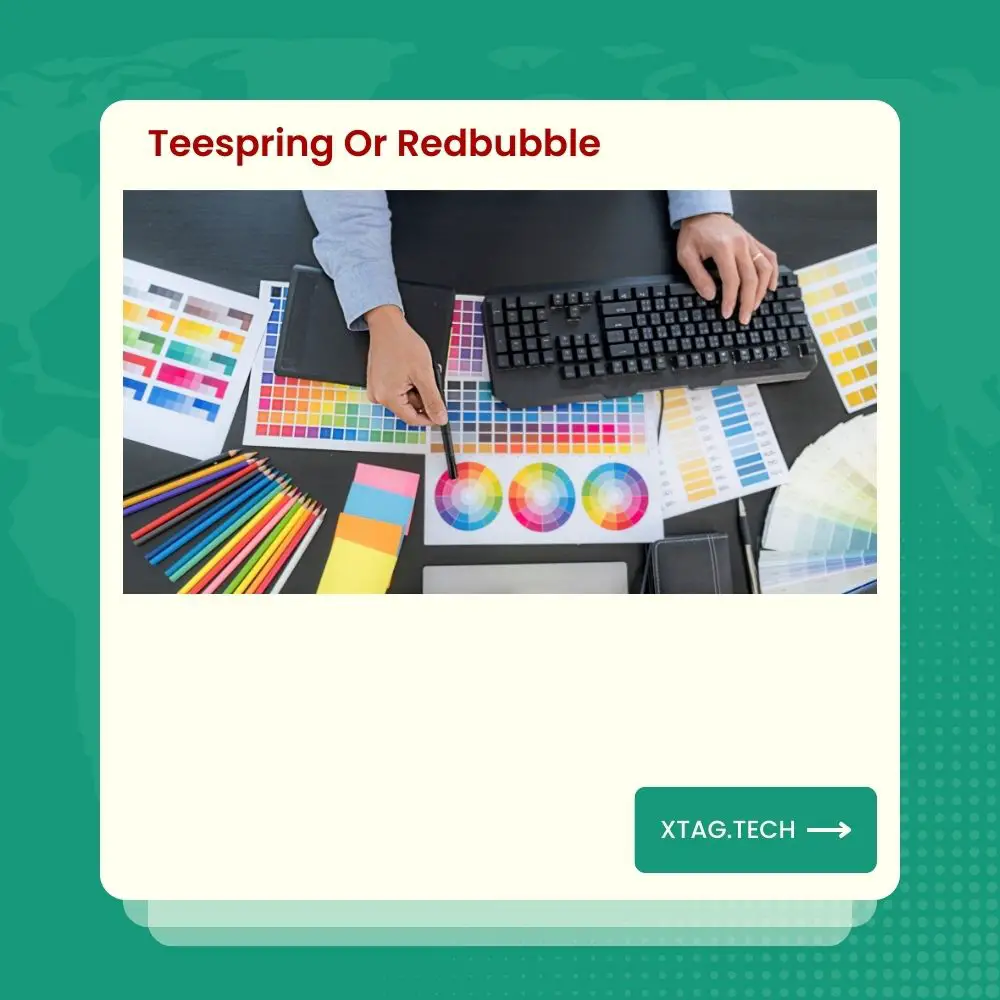
Redbubble is an online marketplace that facilitates the creation and sale of custom products designed by independent artists, illustrators, designers, and photographers. Established in 2006, Redbubble has grown into a vibrant community where creators can showcase their creativity on a diverse range of merchandise.
Services and Features Offered by Redbubble
Redbubble provides an array of services and features to empower creators and sellers:
- Design Freedom:
Creators have the freedom to upload their designs and artwork to be printed on various products, including apparel, stickers, wall art, home decor, and more. - Product Range:
Redbubble offers a wide range of products, allowing artists to diversify their offerings and appeal to a broader audience with their unique designs. - Print-on-Demand Fulfillment:
Redbubble adopts a print-on-demand model, ensuring products are manufactured and shipped as orders are received, minimizing excess inventory and associated costs. - Community and Collaboration:
Redbubble fosters a community atmosphere, encouraging artists to connect, collaborate, and support one another in their artistic endeavors. - Customization and Personalization:
Buyers have the option to personalize products with specific designs, colors, and sizes, tailoring items to their preferences.
Pros and Cons of Redbubble
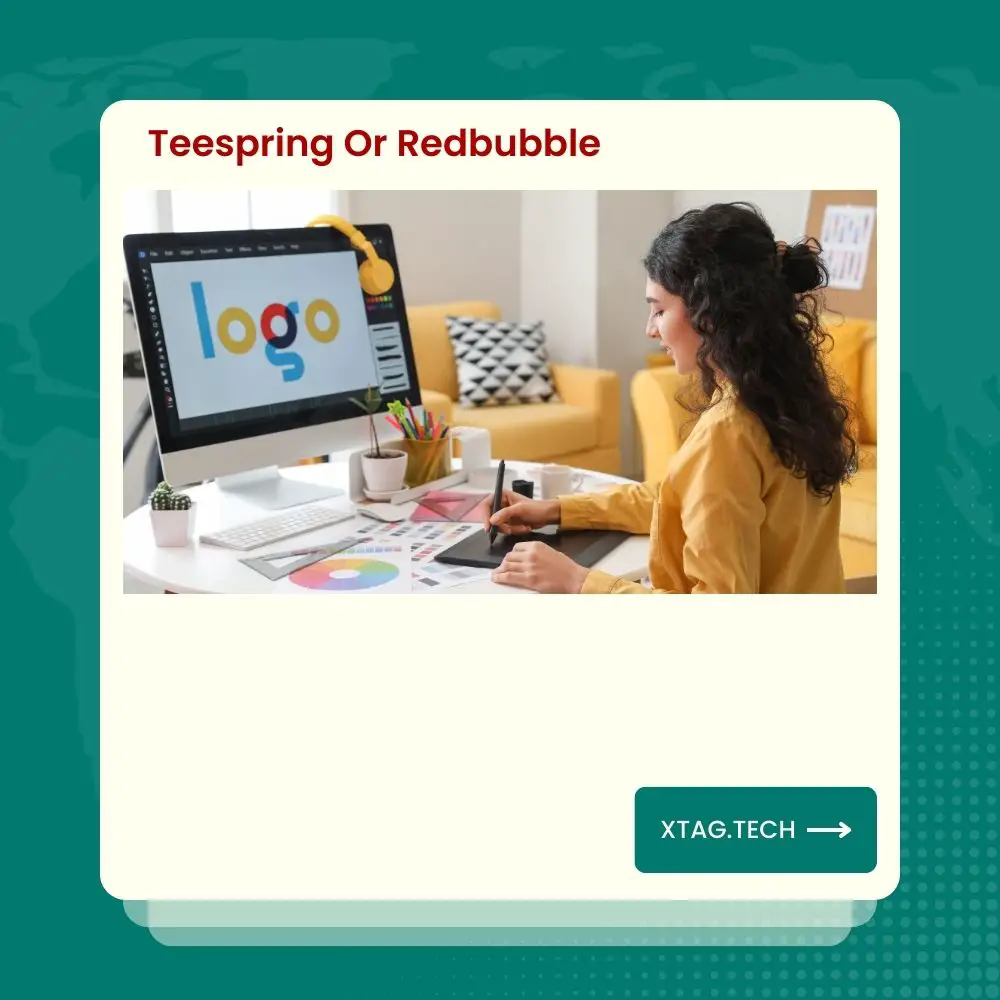
Pros:
- Diverse Product Range: Redbubble offers an extensive selection of products, giving artists the opportunity to showcase their designs on various items.
- Global Reach: The platform has a wide international audience, providing artists with the chance to reach customers from around the world.
- Artistic Community: Redbubble encourages collaboration and provides a platform for artists to share their work and connect with like-minded individuals.
Cons:
- Marketplace Competition: Due to its popularity, Redbubble can be highly competitive, making it essential for creators to strategize their marketing and branding efforts effectively.
- Pricing Pressures: The pricing structure on Redbubble is influenced by market demands, potentially affecting profit margins for sellers.
Next, we’ll delve into a comparison of design and customization features offered by both Teespring and Redbubble.
What is Teespring?
Teespring is an innovative e-commerce platform that empowers individuals and businesses to design and sell custom merchandise online. Founded in 2011, Teespring quickly gained popularity due to its user-friendly interface and the opportunity it provides for creators to monetize their designs without the need for inventory or upfront costs.
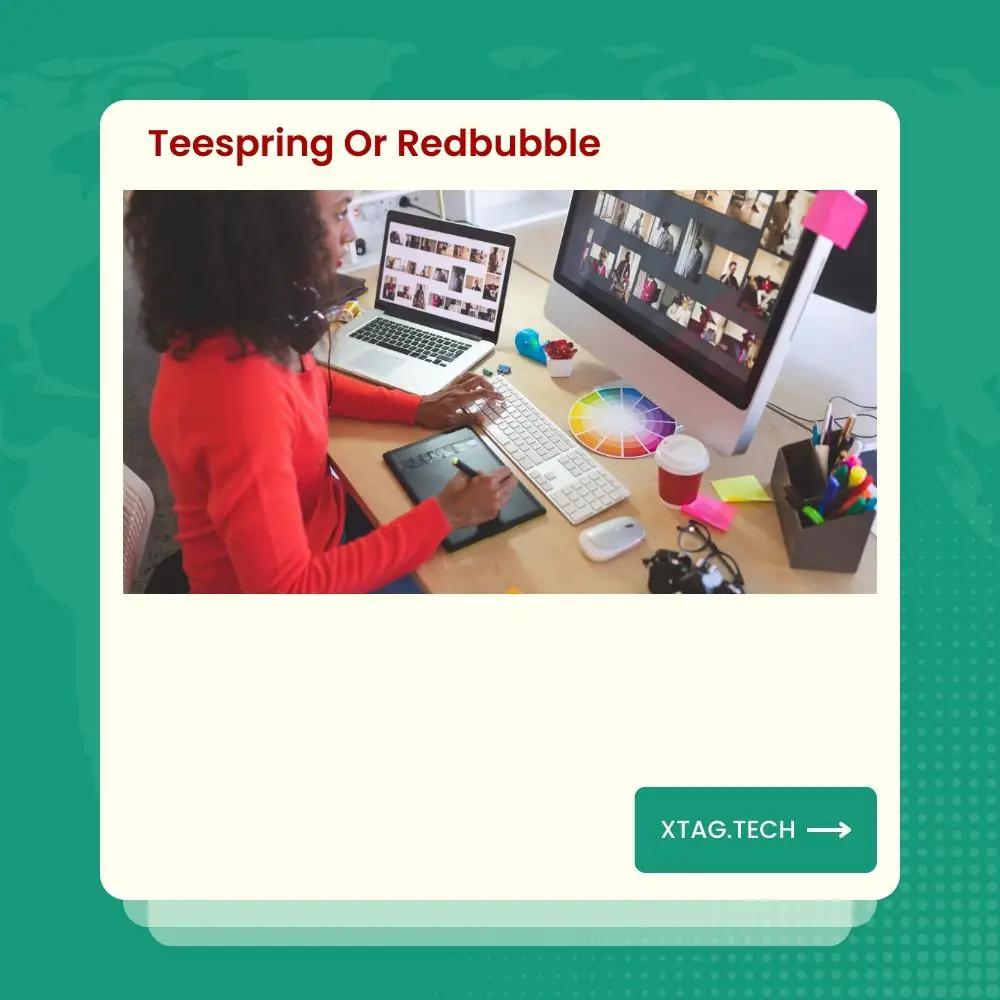
Services and Features Offered by Teespring
Teespring offers a range of services and features tailored to meet the needs of designers and sellers:
- Design Tools:
Teespring’s platform comes equipped with easy-to-use design tools, enabling creators to design apparel, accessories, home decor, and more effortlessly. - Product Customization:
Creators can personalize products with their designs, choosing from a wide array of merchandise options like t-shirts, hoodies, mugs, phone cases, and posters. - E-commerce Storefront:
Teespring provides creators with a customizable storefront where they can showcase their designs and products in a professional manner. - Global Fulfillment:
Teespring handles order fulfillment, printing, and shipping to customers worldwide, reducing the workload and operational hassles for sellers. - Marketing and Analytics:
The platform offers marketing tools and analytics to help sellers optimize their campaigns and track their sales, enabling them to make data-driven decisions.
Pros and Cons of Teespring
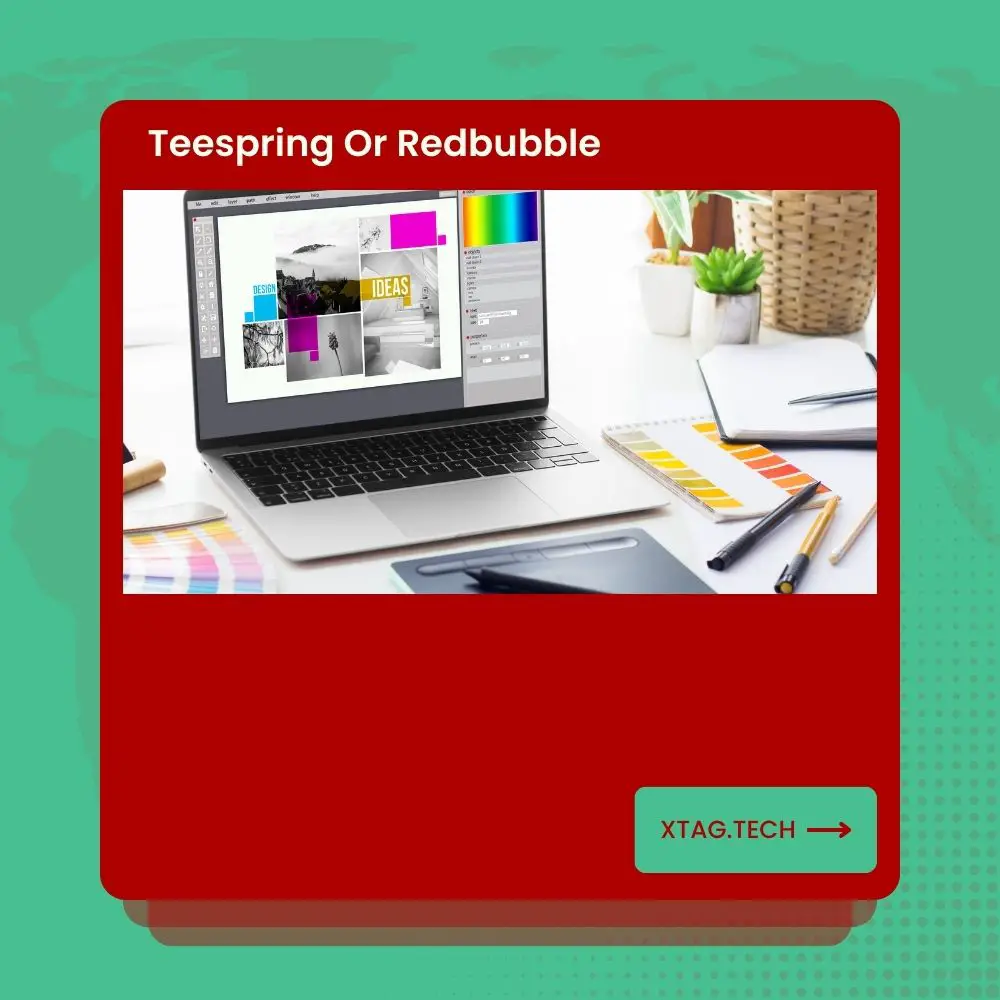
Pros:
- Ease of Use: Teespring’s user-friendly interface allows creators to navigate and design products without technical expertise.
- No Upfront Costs: Creators can start selling their designs without any upfront costs or investment in inventory.
- Global Reach: Teespring’s global fulfillment network ensures that products can be shipped to customers worldwide.
Cons:
- Limited Profit Margins: The platform’s pricing structure may limit the profit potential for sellers, affecting their overall earnings.
- Competitive Market: Given the platform’s popularity, competition among sellers can be high, making it crucial for creators to strategize their marketing efforts effectively.
Design and Customization
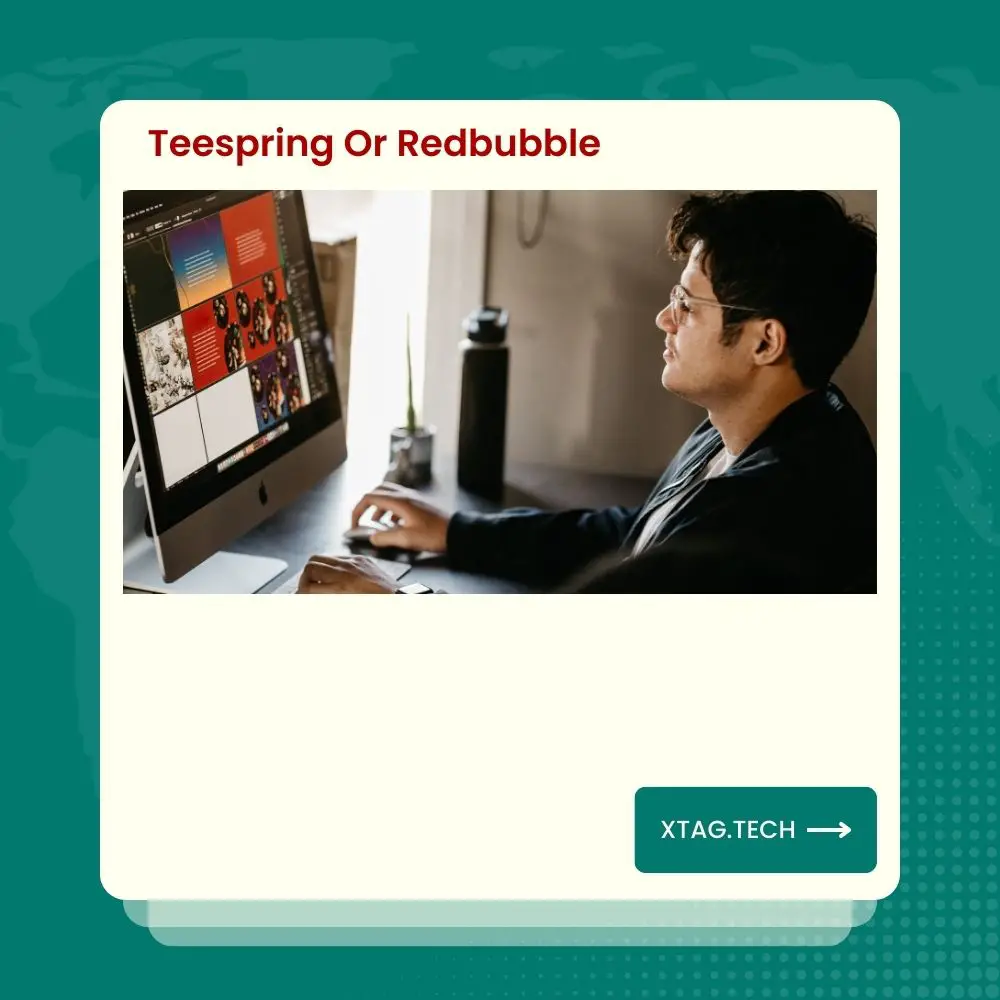
When it comes to custom merchandise platforms like Teespring and Redbubble, design and customization options are crucial aspects that can greatly influence a creator’s experience and a buyer’s choice. Let’s compare the design and customization features offered by these platforms.
Teespring
Teespring’s design and customization process are straightforward and cater to both novices and experienced designers.
- Design Tools:
Teespring provides an intuitive design tool that allows creators to upload artwork, add text, choose fonts, adjust colors, and position their designs on the product canvas. - Design Upload:
Creators can upload their own designs or artwork in various formats, ensuring that their unique creations are accurately replicated on the chosen products. - Product Preview:
Teespring’s platform offers a real-time product preview, enabling creators to see how their designs will look on different items before making them available to buyers.
Redbubble
Redbubble is known for its flexible and creative design process, giving artists the freedom to express themselves uniquely.
- Design Flexibility:
Redbubble offers a more open design platform, allowing creators to upload designs in various formats and choose how they want their artwork to appear on different products. - Product Mockups:
Creators can view mockups of their designs on each product, assisting them in making informed decisions regarding placement, scaling, and colors. - Personalization:
Redbubble allows for product personalization by letting buyers select design colors and product variants to suit their preferences.
Comparison
While both platforms offer customization options, Teespring provides a more streamlined and user-friendly design process, making it particularly suitable for individuals new to the e-commerce world or design. On the other hand, Redbubble provides greater design freedom and flexibility, appealing to artists who want complete control over their design presentations.
Product Range
The range of products offered by a custom merchandise platform can significantly impact the appeal and versatility for both creators and buyers. Let’s examine the product range provided by Teespring and Redbubble.
Teespring
Teespring offers a diverse product catalog, providing options beyond just apparel:
- Apparel: T-shirts, hoodies, sweatshirts, tank tops, and more.
- Accessories: Phone cases, mugs, tote bags, jewelry, and hats.
- Home Decor: Posters, canvases, tapestries, pillows, and blankets.
- Outdoor & Lifestyle: Stickers, magnets, face masks, and socks.
Redbubble

Redbubble is known for its extensive product offering, catering to a wide range of preferences and interests:
- Apparel: T-shirts, hoodies, dresses, leggings, and skirts.
- Accessories: Phone cases, stickers, masks, scarves, and bags.
- Home Decor: Wall art, posters, cushions, blankets, and clocks.
- Stationery: Notebooks, journals, stickers, and greeting cards.
- Gifts: Mugs, coasters, magnets, and keychains.
Comparison
Both Teespring and Redbubble provide a broad range of products, enabling creators to diversify their offerings and appeal to various target audiences. Teespring may have a slightly more focused approach, especially toward apparel and lifestyle products, while Redbubble extends into a broader spectrum of items including clothing, accessories, home decor, and stationery.
Pricing and Profitability
Understanding the pricing structure and profitability for creators is crucial in determining the viability of using a platform like Teespring or Redbubble. Let’s explore how pricing and profit margins work on these platforms.
Teespring
Teespring’s pricing model is relatively straightforward, allowing creators to set their base prices and calculate their profit margins accordingly.
- Base Price: The base price is the minimum amount required to cover the production, fulfillment, and operational costs for Teespring.
- Profit Margin: Creators can set their desired profit margin by determining the selling price above the base price.
- Earnings Calculation: The earnings for each sale are calculated by subtracting the base price from the selling price (base price + profit margin).
Redbubble
Redbubble’s pricing model is a bit different and is influenced by market demands and competition.
- Base Price: Redbubble sets a base price for each product, covering production, fulfillment, and operational costs.
- Markup Percentage: Creators choose a markup percentage to add to the base price, determining their profit margin.
- Selling Price: The selling price is calculated by adding the markup percentage to the base price.
Comparison
In terms of profitability, both platforms provide creators with the ability to set their profit margins, allowing for a degree of control over earnings. Teespring offers more transparent control, enabling creators to see their profit for each sale directly based on the base price and chosen profit margin. Redbubble, on the other hand, involves a fixed base price with a markup percentage, potentially offering competitive pricing based on market trends.
Marketing and Promotion
Effectively marketing and promoting products is vital for generating sales and increasing visibility on custom merchandise platforms like Teespring and Redbubble. Let’s compare the marketing and promotional tools available on these platforms.
Teespring
Teespring offers various tools and features to assist creators in marketing their products:
- Teespring Launcher: A tool that helps creators set up and launch advertising campaigns across social media platforms like Facebook and Instagram.
- Boosted Network: Teespring’s partnership with various e-commerce platforms, extending the reach of products to potential customers.
- Google Shopping Integration: Creators can leverage Teespring’s integration with Google Shopping for broader exposure.
- Social Media Sharing: Integration with popular social media platforms for easy sharing of products within one’s network.
Redbubble
Redbubble also provides tools and opportunities for creators to market their products effectively:
- Redbubble Promotions: Occasional site-wide sales and discounts organized by Redbubble, attracting more buyers.
- Promo Codes: Creators can offer promo codes to incentivize purchases and attract a wider audience.
- Social Media Integration: Allows creators to share their designs and products on various social media platforms directly from their Redbubble profile.
- Artist Affiliate Program: Creators can earn by referring customers to Redbubble through affiliate marketing.
Comparison
Both platforms offer essential marketing and promotional tools, but Teespring stands out with its Teespring Launcher, which simplifies advertising campaign creation. Redbubble, however, provides opportunities for creators to engage in promotional activities, such as site-wide sales and affiliate programs.
Community and Audience Reach
Building a community and reaching a wide audience are vital aspects for success on custom merchandise platforms. Let’s compare the community engagement and audience reach on Teespring and Redbubble.
Teespring
Teespring offers a platform that encourages creators to interact with their audience and build a community:
- Creator Training and Resources: Teespring provides educational materials, webinars, and guides to help creators succeed and build their brand.
- Community Hub: A platform for creators to share their experiences, ask questions, and engage with fellow creators.
- Teespring Forum: A community forum where creators can connect, discuss strategies, and share advice.
Redbubble
Redbubble also emphasizes community engagement and offers resources for creators:
- Redbubble Blog: Regularly updated with informative articles and success stories to inspire and educate creators.
- Redbubble Forums: A community space for creators to discuss various topics, ask questions, and share experiences.
- Social Media Presence: Redbubble is active on social media, engaging with both creators and customers, fostering a sense of community.
Comparison
Both platforms recognize the importance of community and provide resources for creators to connect and learn from each other. Teespring’s approach includes extensive educational materials, while Redbubble focuses on a vibrant online community and social media engagement.
Customer Experience
Ensuring a positive customer experience is essential for retaining customers and encouraging repeat purchases. Let’s compare the customer experience on Teespring and Redbubble.
Teespring
Teespring emphasizes a user-friendly and efficient customer experience:
- Order Management: Teespring handles order fulfillment, including printing and shipping, ensuring a smooth process for customers.
- Customer Support: Teespring provides customer support to address queries and concerns, enhancing the overall experience.
- Refund Policy: Teespring has a refund policy that allows for returns and exchanges in case of issues with the product.
Redbubble
Redbubble also prioritizes a positive customer experience:
- Order Processing: Redbubble manages the printing and shipping process, providing tracking information for orders.
- Customer Support: Redbubble offers customer support to assist with inquiries, order issues, and returns.
- Quality Assurance: Redbubble aims to maintain high-quality products to meet customer expectations.
Comparison
Both Teespring and Redbubble strive to provide a good customer experience by managing the production and shipping processes efficiently and offering responsive customer support. The focus on quality and ease of order management contributes to a positive shopping experience for customers.
Next, let’s summarize the comparison and help readers make an informed decision regarding Teespring and Redbubble.
Conclusion
In the realm of custom merchandise, both Teespring and Redbubble offer distinct opportunities for creators and sellers to showcase their designs and reach a global audience. Let’s summarize the comparison and assist you in making an informed decision based on your requirements and preferences.
- Teespring: Teespring is ideal for creators seeking a user-friendly platform with a streamlined design process. It offers a focused range of products primarily in apparel and lifestyle categories. The pricing structure allows for direct control over profit margins, and the platform provides marketing tools to support creators in reaching their target audience.
- Redbubble: Redbubble provides a broader product range, catering to various interests and preferences. It’s known for design flexibility, allowing creators to tailor their designs to specific products. While the pricing structure is influenced by market demands, it offers a wide range of products and opportunities for creators to participate in site-wide promotions.
Which Platform Is Best for You?
- Choose Teespring if:
- You prefer a straightforward design process.
- Your focus is primarily on apparel and lifestyle products.
- You want direct control over pricing and profit margins.
- Choose Redbubble if:
- You seek design flexibility and a diverse product range.
- You want to explore various niches and interests.
- You appreciate a vibrant community and potential for site-wide promotions.
Ultimately, the decision between Teespring and Redbubble depends on your design style, target market, and business goals.
In this digital age, expressing creativity and reaching a global audience is easier than ever. Utilize the strengths of these platforms to showcase your designs and build a thriving brand in the world of custom merchandise.
Frequently Asked Questions (FAQs)
1. How do Teespring and Redbubble compare in terms of earnings for creators?
Teespring allows creators to set their profit margins by determining a selling price above the base price, providing more direct control over earnings. Redbubble, however, uses a markup percentage on a fixed base price, influencing profit margins based on market trends and competition.
2. Which platform offers a wider range of products?
Redbubble offers a broader product range, spanning apparel, accessories, home decor, stationery, and gifts. Teespring, while diverse, has a more focused product selection primarily centered around apparel and lifestyle products.
3. How user-friendly are the design tools on Teespring and Redbubble?
Teespring provides a user-friendly design tool that is ideal for both beginners and experienced designers. Redbubble offers a more flexible design platform, allowing for greater control and customization, suitable for artists seeking creative freedom.
4. How do Teespring and Redbubble support marketing and promotion?
Teespring offers tools like Teespring Launcher and integration with social media, while Redbubble provides periodic site-wide promotions, promo codes, and an affiliate program. Both platforms encourage creators to share their products on social media to expand their reach.
5. Can I use both platforms simultaneously to maximize my reach?
Yes, many creators use both Teespring and Redbubble simultaneously to maximize their exposure and potential sales. Utilizing multiple platforms can broaden your reach and allow you to cater to different audiences and preferences.
These FAQs should provide additional clarity regarding the differences between Teespring and Redbubble, helping you make an informed decision based on your specific needs and goals.
